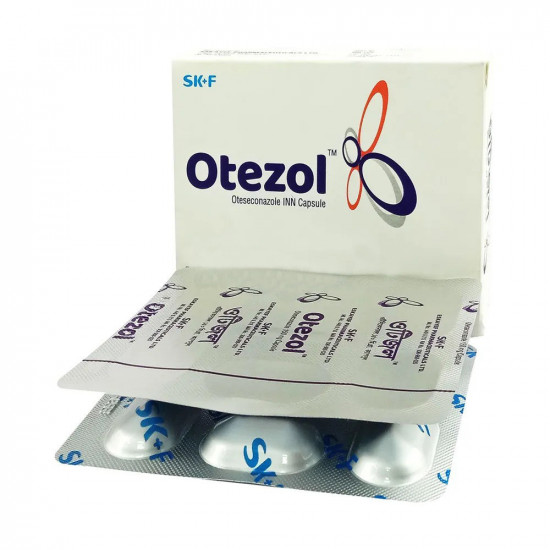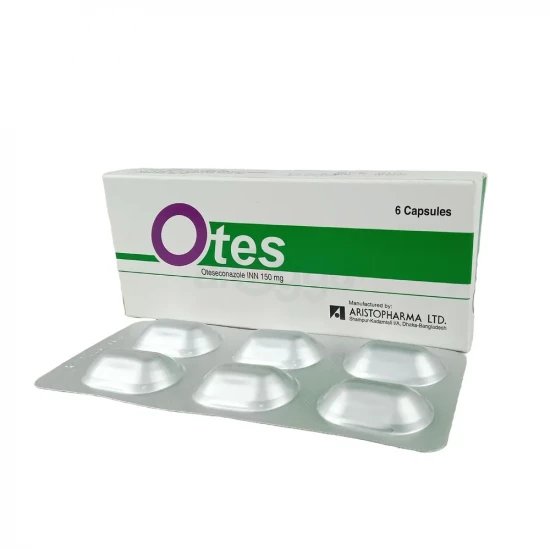
✔ 100% Authentic Product
👁️ Currently Viewing 1678
Otegal 150 | 10 Capsules
Otegal is indicated for the reduction of recurrent vulvovaginal candidiasis (RVVC) episodes in adult females who are not of reproductive potential. While fungal culture results can guide therapy, treatment may be initiated prior to receiving laboratory confirmation. Adjust treatment based on culture findings when available.
- Pediatric: Not recommended due to contraindication in reproductive-aged females.
- Geriatric: Insufficient data; caution advised.
- Renal Impairment: No dose adjustment needed in mild to moderate cases.
- Hepatic Impairment: No adjustment necessary for mild liver dysfunction (Child-Pugh A).
Discount
Price: ৳ 1,649
MRP:
৳
1700
3%
Off

100% Genuine Products, Guaranteed

Safe & Secure Payments, Always

Fast, Secure & Efficient Delivery

Proper Packaging
 Cash on Delivery - All over Bangladesh
Cash on Delivery - All over Bangladesh Regular Delivery - 12-24 Hours, Dhaka City* Charge Tk.39-59
Regular Delivery - 12-24 Hours, Dhaka City* Charge Tk.39-59 Regular Delivery - 24-48 Hours, Other Cities* Charge Tk.99-110
Regular Delivery - 24-48 Hours, Other Cities* Charge Tk.99-110
 ফ্রি ডেলিভারিঃ - ৯৯৯ টাকা+ অর্ডারে, ঢাকা
শহরে
ফ্রি ডেলিভারিঃ - ৯৯৯ টাকা+ অর্ডারে, ঢাকা
শহরে ফ্রি ডেলিভারিঃ - ২৯৯৯ টাকা+ অর্ডারে, ঢাকার
বাহিরে
ফ্রি ডেলিভারিঃ - ২৯৯৯ টাকা+ অর্ডারে, ঢাকার
বাহিরে
100% Genuine Products, Guaranteed
Safe & Secure Payments, Always
Fast, Secure & Efficient Delivery
Proper Packaging
 Cash on Delivery - All over Bangladesh
Cash on Delivery - All over Bangladesh Regular Delivery - 12-24 Hours, Dhaka City* Charge Tk.39-59
Regular Delivery - 12-24 Hours, Dhaka City* Charge Tk.39-59 Regular Delivery - 24-48 Hours, Other Cities* Charge Tk.99-110
Regular Delivery - 24-48 Hours, Other Cities* Charge Tk.99-110 ফ্রি ডেলিভারিঃ - ৯৯৯ টাকা+ অর্ডারে, ঢাকা
শহরে
ফ্রি ডেলিভারিঃ - ৯৯৯ টাকা+ অর্ডারে, ঢাকা
শহরে ফ্রি ডেলিভারিঃ - ২৯৯৯ টাকা+ অর্ডারে, ঢাকার
বাহিরে
ফ্রি ডেলিভারিঃ - ২৯৯৯ টাকা+ অর্ডারে, ঢাকার
বাহিরে
✅ Description:
Oteseconazole is a novel antifungal agent from the azole class. It selectively inhibits the fungal enzyme 14α-demethylase (CYP51)—crucial for ergosterol biosynthesis, an essential component of the fungal cell membrane. Disruption of this process compromises fungal cell integrity and viability. The drug's tetrazole moiety gives it high specificity for fungal enzymes while minimizing interaction with human cytochrome P450 enzymes.
✔️ Side Effects
Common adverse reactions (≥2% incidence) include:
- Headache
- Nausea
✔️ Dosage & Administration
There are two approved dosing regimens:
1. Oteseconazole-Only Regimen
Day 1: 600 mg (single dose)
Day 2: 450 mg (single dose)
From Day 14 onwards: 150 mg once weekly for 11 weeks (Week 2 to Week 12)
2. Fluconazole + Oteseconazole Regimen
Day 1, 4, 7: Fluconazole 150 mg orally
Day 14 to 20: Oteseconazole 150 mg daily
From Day 28 onwards: Oteseconazole 150 mg once weekly for 11 weeks (Week 4 to Week 14)
👉 Take with food. Swallow capsules whole—do not crush or chew.
✔️ Drug Interactions
BCRP substrates (e.g., rosuvastatin): Caution advised. Co-administration may increase plasma levels of these drugs. Use the lowest effective dose of the interacting drug and monitor for side effects.
Minimal interaction risk with CYP enzymes, based on in vitro data.
✔️ Contraindications
- Women of reproductive potential
- Pregnant or breastfeeding women
- Patients with known hypersensitivity to oteseconazole or any excipients
✔️ Pregnancy & Lactation
Contraindicated during pregnancy and in females who can become pregnant. Based on animal studies, oteseconazole can cause fetal harm, including ocular malformations. Its prolonged half-life (approx. 138 days) results in a drug exposure window of nearly 690 days, increasing the risk of embryo-fetal toxicity. Use is also not recommended during lactation due to the unknown safety in breastfed infants.
✔️ Precautions & Warnings
Embryo-fetal toxicity is a major concern; Otegal should not be used in any female of childbearing potential.
Animal studies have shown risks of ocular defects in offspring when used during pregnancy.
✔️ Storage Conditions
- Store at 20°C to 25°C
- Protect from light after removing from packaging
- Keep out of reach of children
⚠️Disclaimer:
At ePharma, we’re committed to providing accurate and accessible health information. However, all content is intended for informational purposes only and should not replace medical advice from a qualified physician. Please consult your healthcare provider for personalized guidance. We aim to support, not substitute, the doctor-patient relationship.









